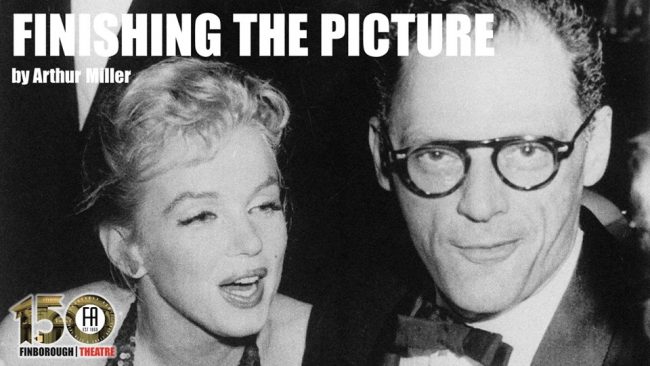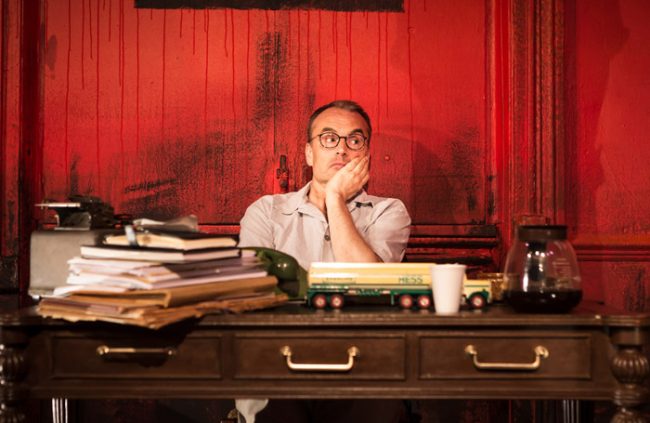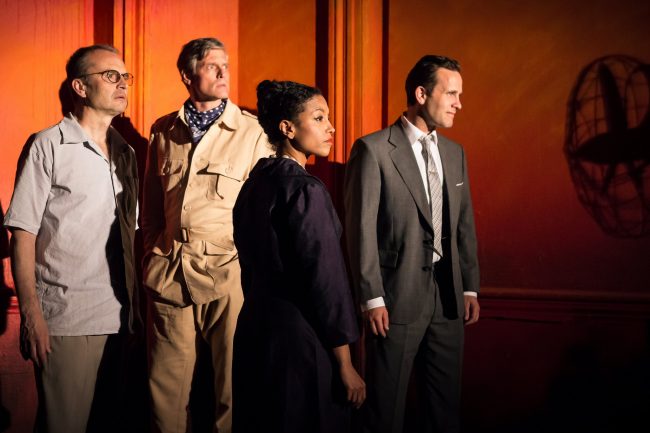
Arthur Miller’s last play, Finishing the Picture, has opened at London’s Finborough Theatre to mostly positive reviews – although some critics have questioned why Kitty (the Marilyn-based character) is so constantly talked about, but never actually seen. Only the second production (and first in Europe), it’s on until July 7.
“The play itself is a pretty static thing, involving much talking in circles as to how to coax the radiantly beautiful and gifted Kitty (Monroe) out of her crippling self doubt and drug dependency in order to complete filming and save her from herself. Crucially, Kitty never appears on stage and has no voice, rendering her the kind of unknowable goddess/tormentor … indeed the whole piece has the feel of an exercise to seek ‘closure’ for this chapter of his life.” – The Stage
“The cohesive group of actors deliver strong performances from start to finish … A jarring peek into the ugly truth behind the idealisation of film stars opposed to the reality of the profession, Miller’s final play becomes of momentous meaning in the aftermath of the Weinstein scandal.” – Broadway World
“Even as all the production members attempt to cajole Kitty into emerging from her hotel room and returning to set, there is a sense that their supposed concern for her is secondary: they will say whatever they must to save the picture … the ensemble do not seem to appreciate their culpability in the downfall of women like Monroe, and even by the play’s conclusion there is a sense that, even as Kitty has a slight chance of recovery, it may only be temporary.” – Reviews Hub
“It’s an interesting decision Miller made not to give Kitty herself a voice, but to show how those around her project on to this blank screen their own preoccupations and prejudices. The trouble is, we end up with very little idea of why Kitty is having a breakdown. In his programme note, director Phil Willmott alludes to the Weinstein scandal and #MeToo movement, but sexual abuse of women in Hollywood doesn’t really feature in the play — even if it is implied that Kitty is regarded as a commodity.” – Londonist,
“Finishing the Picture feels like an exorcism, a celebration, an apology and an inquest – it’s a patchy but powerful look at the dark forces that made Monroe such a vital but troubled personality … Miller has elected to keep Kitty entirely off-stage. It’s a clever device, which emphasises Kitty’s loneliness, but it sucks the life out of the play. Everything is reported, precious little happens and the most interesting character doesn’t get a look in.” – The Guardian
“Forty years on from his After the Fall, [Miller] returned to trying to explain – not excuse, not quite – the disintegration of his relationship with Monroe, alias Kitty. Here, he reserves his full venom for Method acting gurus Lee and Paula Strasberg … Yet Miller the playwright’s concern for Monroe seems as effortful as that of Paul, the Miller character. The biggest surprise, puzzle and disappointment is that, for someone so evidently haunted by the memory, Miller can in the end (literally, for him, the end) offer so little unique insight.” – Financial Times
“This is a tribute play. Miller had true affection for Monroe and with Finishing The Picture, this is clearly on show. An incredible look at the power of and the absurdity of unchecked ego. Phil Willmott’s skilful direction expertly bringing this passionate play to life.” – Boyz
“The history is fascinating (for a while at least), but the play less so. It is hampered by the fact that Kitty is always off stage. Instead we get snippets from lives of less importance … you can feel the claustrophobia here of being stuck in a hotel in the middle of nowhere. But I soon got bored with the seesaw drama of Kitty’s ability to stand up.” – The Times
“The intimate setting of the Finborough Theatre provides a perfect foreground for Miller’s innermost thinking to unpack. Herein, the audience are given a rare glimpse into the dark imperfections of Monroe’s character and how those in her orbit, superbly brought to life by the performing ensemble, struggle to pacify her mercurial tendencies.” – KCW Today
“Like many old men’s plays (think of Shakespeare’s The Tempest or Ibsen’s When We Dead Awaken), it is spare and static. But it is admirably animated by director Phil Willmott with a skilful use of music and sound effects to represent the unseen Kitty.” – Daily Express



